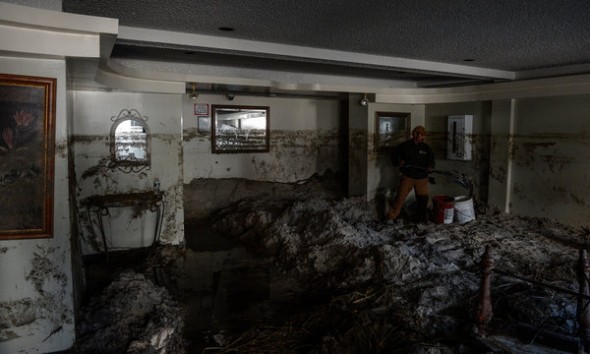November 05, 2012

Workers on Monday were using buckets to clean out the bottom floor of a residence in Long Beach, on Long Island. Many of the homes along the South Shore were damaged heavily by sand and water from Hurricane Sandy. Photo: Robert Stolarik for The New York Times
Officials said they were working on Monday to provide temporary housing for people displaced by Hurricane Sandy despite confusion and conflicting accounts of how many needed places to live.
“We don’t really know yet, in truth,” Gov. Andrew M. Cuomo said at a briefing, adding that the estimates ranged from 10,000 to 40,000 people. “You’re going to have some people who need short-term housing solutions and some who need long-term housing solutions, and those are two different things.”
“It is manageable; it is large,” Mr. Cuomo added, saying the federal government “would defray the cost with us.”
Federal officials said more than 45,000 families had been approved for housing assistance totaling more than $203 million — money that would let them find a temporary place to live or repair damage to their homes.
The approvals were the start of a housing assistance program that will accelerate in the coming weeks, as tens of thousands of people left homeless by the storm look for places to stay while their homes or apartment buildings are repaired.
A small number of families — about 450 who have checked into hotels so far, officials said — have been approved for stays in hotels paid directly by the federal government. Federal officials said they were approving the rental assistance and hotel stays because even after utilities were reconnected, thousands of people could not simply return to houses that had sustained serious damage and needed major work.
“As power comes on, it is becoming clear for many people the longer-term issue will be rebuilding and repairing their homes,” said W. Craig Fugate, administrator of the Federal Emergency Management Agency.
Shaun Donovan, the secretary of housing and urban development, which subsidizes tens of thousands of its housing units in New York and New Jersey, said the agency was still working on figuring out how many units would need to be renovated, forcing residents to relocate until the work was done.
So far, that count is relatively small, he said, including one complex in Atlantic City. But it will climb in the coming days as the assessments are completed.
The homeland security secretary, Janet Napolitano, who visited Coney Island on Monday, noted that the storm had hit public housing particularly hard. She said that for housing-project residents and others displaced by the storm, “no option is off the table” for temporary housing, including rental units, hotel and motel rooms, trailers and prefabricated units.
Mayor Michael R. Bloomberg said housing projects in New York City were recovering. Of 402 buildings run by the New York City Housing Authority that were hit by the storm, 174 buildings still lacked heat and hot water and 114 lacked power. He said the authority had pumped out all its flooded buildings.
“The big numbers come down quickly,” Mr. Bloomberg said at a briefing. “The challenge is that when we get down to the hard core of real problems where there’s no quick, easy, inexpensive fix, that’s when we’re going to really going to be challenged.”
He said he had appointed a former deputy commissioner of the city’s Office of Emergency Management and former federal recovery officer for 9/11, Brad Gair, to direct housing recovery operations, overseeing the city’s efforts to find housing for people displaced by the storm.
The mayor said Mr. Gair would start by preparing an inventory of “transitional and temporary housing options” and coordinate efforts to move people into short-term quarters.
Officials in New Jersey said they had asked for assistance from out-of-state inspectors to help let people back into their homes faster, and a unit of the State Department of Community Affairs planned to start electrical and building inspections later in the week. FEMA officials said that more than 1,070 housing inspectors were at work in New York, with another 700 in New Jersey and 46 in Connecticut.
In some communities on Long Island, building inspectors were already going from one storm-damaged house to the next, inspecting circuit breakers and notifying the Long Island Power Authority whether power could be turned on safely.
Communication and coordination remained spotty. Officials in Nassau and Suffolk Counties, saying they were still reaching out to towns and villages to assess temporary housing needs, declined to provide estimates. Vanessa Baird-Streeter, the communications director for Suffolk County, said about 10,000 homes had been damaged, but she said officials were still determining how many were uninhabitable.
Up and down the storm-ravaged South Shore, local officials reported widespread needs.
“We need housing bad,” said Mayor Andrew Hardwick of Freeport, a seaside community of about 43,000 in Nassau County.
He said that flooding had damaged 2,000 to 3,000 homes in Freeport and that many families had continued to occupy their damaged homes. Many may be forced out as the weather turns colder and mold in their waterlogged homes grows and spreads.
Mr. Hardwick said he had asked for 100 FEMA trailers and would install them on athletic fields and in schoolyards.
But he had a more immediate — and potentially more permanent — idea in mind. He said he had asked the federal government to intercede with banks to convert two private housing developments that were completed but went unoccupied after the housing market collapsed.
“We could put in a team of tradespeople to go in and bring the electrical systems and plumbing up to code,” he said. “That could be a lot quicker than putting mobile homes in place.”
Source: The New York Times

Leave a Reply